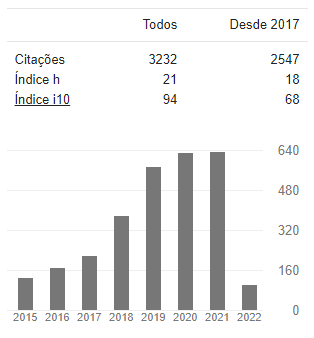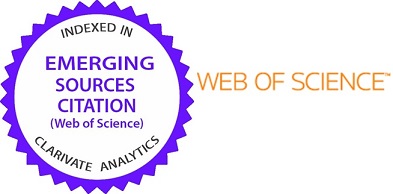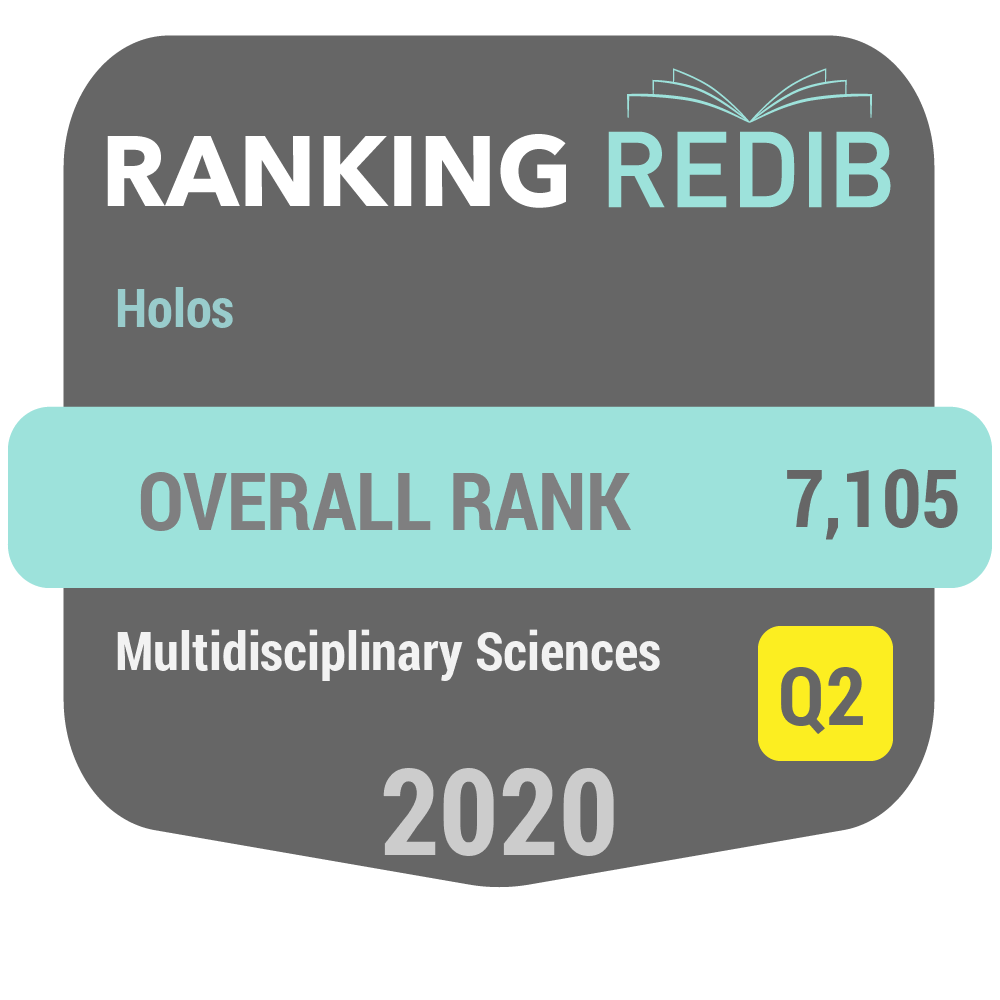ANÁLISE DA COMUNIDADE MICROBIOLÓGICA E A GERAÇÃO DE ENERGIA POR CÉLULAS DE ENERGIA MICROBIOLÓGICAS COM DIFERENTES TIPOS DE ANODOS
DOI:
https://doi.org/10.15628/holos.2020.5645Palavras-chave:
células de energia microbiológica, análise de comunidade bacteriológica, bioenergia, tratamento de efluentes.Resumo
As Células de Energia Microbiológicas (CEMs) são uma tecnologia promissora na geração de bioeletricidade a partir de biomassa usando bactérias, ou seja, convertendo resíduos em produtos energéticos. Este estudo usou uma câmara de CEM simples e amostras de efluente de uma estação de tratamento de efluentes municipal para converter energia. De forma a verificar a eficiência da CEM, cinco câmaras simples foram utilizadas, cada uma com sua própria conformidade de material anódico. As câmaras consistiram de quatro Discos de Carbono (DC) com composições variáveis de carbono e uma Escova de Fibra de Carbono (EFC). As densidades de potência máxima de EFC, DC1 e DC2 mostraram uma tendência decrescente, sendo esta 24mW/m3, 20mW/m3, 8mW/m3, respectivamente. A análise da comunidade microbiológica foi realizada para comparar a composição microbiológica encontrada em cada câmara e identificar uma possível relação na geração de bioeletricidade. Os resultados através da Clonagem Shotgun e DGGE mostraram que os microrganismos na câmara EFC foram os que variaram mais. Uma vez que ambos os grupos Geobacter e Chlorobium foram identificados como os mais predominantes, uma análise por q-PCR foi conduzida. A porcentagem entre os grupos foi de 80, 92 e 95% para Chlorobium e 55, 25 e 10% para Geobacter nas câmaras EFC, DC1 e DC2, respectivamente. A relação simbiótica de Chlorobium e Geobacter pode ser a chave para se aumentar a quantidade de eletricidade produzida biologicamente com este tipo de efluente.Downloads
Referências
Baron, D., LaBelle, E., Coursolle, D., Gralnick, J. A., & Bond, D. R. (2009). Electrochemical Measurement of Electron Transfer Kinetics by Shewanella oneidensis MR-1. Journal of Biological Chemistry, 284(42), 28865-28873. doi: 10.1074/jbc.M109.043455
Bond, D. R., & Lovley, D. R. (2003). Electricity Production by Geobacter sulfurreducens Attached to Electrodes. Applied and Environmental Microbiology, 69(3), 1548-1555. doi: 10.1128/AEM.69.3.1548-1555.2003
Cho, Y. K., Donohue, T. J., Tejedor, I., Anderson, M. A., McMahon, K. D., & Noguera, D. R. (2008). Development of a solar?powered microbial fuel cell. Journal of Applied Microbiology, 104(3), 640-650. doi: 10.1111/j.1365-2672.2007.03580.x
Dias, F., Mesquita Oliveira, F., de Oliveira Matias, L., & Martins Fernandes, T. (2019). Enriquecimento nutricional de resíduos de algas do gênero Gracilaria sp. utilizando Saccharomyces cerevisiae através do cultivo semisólido. HOLOS, 7, 1-18. doi:https://doi.org/10.15628/holos.2019.3451
Das, S., & Mangwani, N. (2010). Recent developments in microbial fuel cells: a review. JOURNAL OF SCIENTIFIC & INDUSTRIAL RESEARCH, 69(10), 727-731.
Fricke, K., Harnisch, F., & Schroder, U. (2008). On the use of cyclic voltammetry for the study of anodic electron transfer in microbial fuel cells. ENERGY & ENVIRONMENTAL SCIENCE, 1(1), 144-147. doi: 10.1039/b802363h
Greenman, J., Gálvez, A., Giusti, L., & Ieropoulos, I. (2009). Electricity from landfill leachate using microbial fuel cells: Comparison with a biological aerated filter. Enzyme and Microbial Technology, 44(2), 112-119. doi: 10.1016/j.enzmictec.2008.09.012
Hu, Z. (2008). Electricity generation by a baffle-chamber membraneless microbial fuel cell. Journal of Power Sources, 179(1), 27-33. doi: 10.1016/j.jpowsour.2007.12.094
Huang, L., & Logan, B. E. (2008). Electricity generation and treatment of paper recycling wastewater using a microbial fuel cell. Applied Microbiology and Biotechnology, 80(2), 349-355. doi: 10.1007/s00253-008-1546-7
Jia, Y.-H., Tran, H.-T., Kim, D.-H., Oh, S.-J., Park, D.-H., Zhang, R.-H., & Ahn, D.-H. (2008). Simultaneous organics removal and bio-electrochemical denitrification in microbial fuel cells. Bioprocess and biosystems engineering, 31(4), 315-321. doi: 10.1007/s00449-007-0164-6
Katuri, K. P., & Scott, K. (2010). Electricity generation from the treatment of wastewater with a hybrid up?flow microbial fuel cell. Biotechnology and bioengineering, 107(1), 52-58.
Ki, D., Park, J., Lee, J., & Yoo, K. (2008). Microbial diversity and population dynamics of activated sludge microbial communities participating in electricity generation in microbial fuel cells. WATER SCIENCE AND TECHNOLOGY, 58(11), 2195-2201. doi: 10.2166/wst.2008.577
Kim, H. J., Hyun, M. S., Chang, I. S., & Kim, B. H. (1999). A microbial fuel cell type lactate biosensor using a metal-reducing bacterium, Shewanella putrefaciens. JOURNAL OF MICROBIOLOGY AND BIOTECHNOLOGY, 9(3), 365-367.
Lee, T. K., Van Doan, T., Yoo, K., Choi, S., Kim, C., & Park, J. (2010). Discovery of commonly existing anode biofilm microbes in two different wastewater treatment MFCs using FLX Titanium pyrosequencing. Applied Microbiology and Biotechnology, 87(6), 2335-2343. doi: 10.1007/s00253-010-2680-6
Li, X., & Jia, R. (2008). Decolorization and biosorption for Congo red by system rice hull- Schizophyllum sp. F17 under solid-state condition in a continuous flow packed-bed bioreactor. BIORESOURCE TECHNOLOGY, 99(15), 6885-6892. doi: 10.1016/j.biortech.2008.01.049
Liu, H., Ramnarayanan, R., & Logan, B. E. (2004). Production of electricity during wastewater treatment using a single chamber microbial fuel cell. ENVIRONMENTAL SCIENCE & TECHNOLOGY, 38(7), 2281-2285. doi: 10.1021/es034923g
Lloyd, J. R., Lovley, D. R., & Macaskie, L. E. (2003). Biotechnological Application of Metal-reducing Microorganisms (Vol. 53, pp. 85-128). United States: Elsevier Science & Technology.
Logan, B. E. (2008). Microbial Fuel Cells (Vol. 1st). Hoboken: Wiley.
Logan, B. E., & Regan, J. M. (2006). Electricity-producing bacterial communities in microbial fuel cells. TRENDS in Microbiology, 14(12), 512-518.
Lovley, D. R. (2006). Microbial fuel cells: novel microbial physiologies and engineering approaches. Current opinion in biotechnology, 17(3), 327-332.
Lovley, D. R. (2009). Future shock from the microbe electric. Microbial biotechnology, 2(2), 139-141. doi: 10.1111/j.1751-7915.2009.00090_9.x
Marsili, E., Baron, D. B., Shikhare, I. D., Coursolle, D., Gralnick, J. A., & Bond, D. R. (2008). Shewanella Secretes Flavins That Mediate Extracellular Electron Transfer. Proceedings of the National Academy of Sciences of the United States of America, 105(10), 3968-3973. doi: 10.1073/pnas.0710525105
Murali, V., Ong, S. A., Ho, L. N., Wong, Y. S., & Hamidin, N. (2013). Comprehensive Review and Compilation of Treatment for Azo Dyes Using Microbial Fuel Cells. WATER ENVIRONMENT RESEARCH, 85(3), 270-277. doi: 10.2175/106143012X13503213812481
Pant, D., Van Bogaert, G., Diels, L., & Vanbroekhoven, K. (2010). A review of the substrates used in microbial fuel cells (MFCs) for sustainable energy production. BIORESOURCE TECHNOLOGY, 101(6), 1533-1543. doi: 10.1016/j.biortech.2009.10.017
Potter, M. C. (1911). Electrical Effects Accompanying the Decomposition of Organic Compounds. Proceedings of the Royal Society of London. Series B, Containing Papers of a Biological Character, 84(571), 260-276.
Qian, F., & Morse, D. E. (2011). Miniaturizing microbial fuel cells. Trends in Biotechnology, 29(2), 62-69. doi: 10.1016/j.tibtech.2010.10.003
Rabaey, K., Boon, N., Siciliano, S. D., Verhaege, M., & Verstraete, W. (2004). Biofuel Cells Select for Microbial Consortia That Self-Mediate Electron Transfer. Applied and Environmental Microbiology, 70(9), 5373-5382. doi: 10.1128/AEM.70.9.5373-5382.2004
Rezaei, F., Richard, T. L., & Logan, B. E. (2008). Enzymatic hydrolysis of cellulose coupled with electricity generation in a microbial fuel cell. Biotechnology and bioengineering, 101(6), 1163-1169.
Richter, H., Nevin, K. P., Jia, H. F., Lowy, D. A., Lovley, D. R., & Tender, L. M. (2009). Cyclic voltammetry of biofilms of wild type and mutant Geobacter sulfurreducens on fuel cell anodes indicates possible roles of OmcB, OmcZ, type IV pili, and protons in extracellular electron transfer. ENERGY & ENVIRONMENTAL SCIENCE, 2(5), 506-516. doi: 10.1039/b816647a
Sharma, V., & Kundu, P. P. (2010). Biocatalysts in microbial fuel cells. Enzyme and Microbial Technology, 47(5), 179-188. doi: 10.1016/j.enzmictec.2010.07.001
Shizas, I., & Bagley, D. M. (2004). Experimental determination of energy content of unknown organics in municipal wastewater streams. JOURNAL OF ENERGY ENGINEERING-ASCE, 130(2), 45-53. doi: 10.1061/(ASCE)0733-9453(2004)130:2(45)
Sun, M., Sheng, G.-P., Mu, Z.-X., Liu, X.-W., Chen, Y.-Z., Wang, H.-L., & Yu, H.-Q. (2009). Manipulating the hydrogen production from acetate in a microbial electrolysis cell–microbial fuel cell-coupled system. Journal of Power Sources, 191(2), 338-343. doi: 10.1016/j.jpowsour.2009.01.087
Sun, Y. M., Wei, J. C., Liang, P., & Huang, X. (2011). Electricity generation and microbial community changes in microbial fuel cells packed with different anodic materials. BIORESOURCE TECHNOLOGY, 102(23), 10886-10891. doi: 10.1016/j.biortech.2011.09.038
Torres, C. (2012). Improving microbial fuel cells. Membrane Technology, 2012(8), 8-9.
Zuo, Y., Maness, P. C., & Logan, B. E. (2006). Electricity production from steam-exploded corn stover biomass. ENERGY & FUELS, 20(4), 1716-1721. doi: 10.1021/ef060033l









































